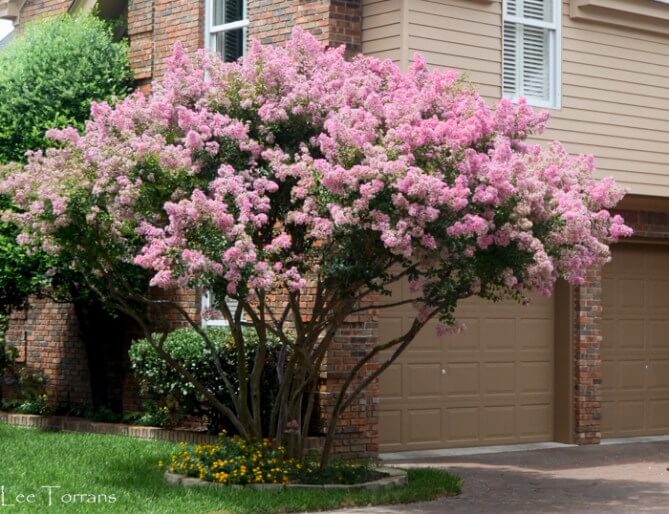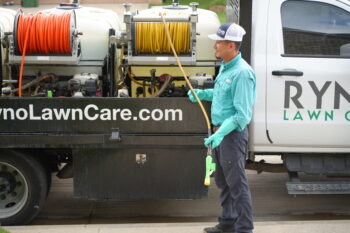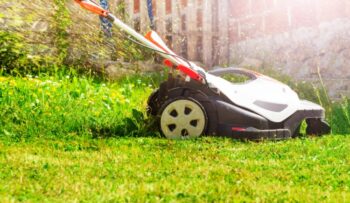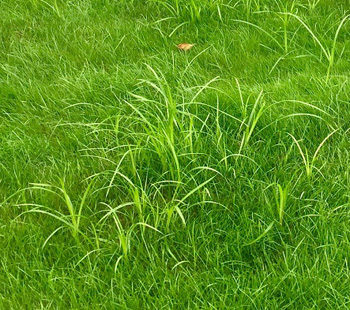People cherish crepe myrtles, aka, crape myrtles for their vibrant blooms and ability to thrive in warmer climates. But, if you’ve noticed your crepe myrtle turning black, chances are you’re dealing with a common pest problem.
Blackened leaves, stems, and bark make your tree look diseased and unattractive. If left untreated, these issues will reduce the health and vitality of the tree. In this article, we’ll explore the likely causes behind this black coating—aphids and crepe myrtle bark scale—along with treatment options and signs it’s time to call a professional.
Understanding the Culprits: Aphids and Crepe Myrtle Bark Scale
Two primary pests are responsible for causing crepe myrtles to turn black: aphids and crepe myrtle bark scale (CMBS). These insects infest crepe myrtles and create conditions that promote the growth of sooty mold. Sooty mold ultimately, develops into that unsightly black coating.
Gibson (2024) often times, the first sign of CMBS is the black sooty mold on the tree bark. This may be misleading since a more common and easy to control pest, aphids, can also cause sooty mold. Closely examine the affected areas to properly identify the pest.
Aphids
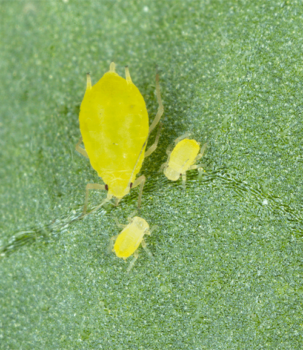
These tiny, soft-bodied insects are sap-suckers that attach to crepe myrtle leaves and stems, draining nutrients from the tree. As they feed, aphids release a sticky substance called honeydew. Honeydew serves as a food source for a type of black fungus known as sooty mold. It spreads quickly and creates a dark, powdery layer over the leaves, stems, and branches.
Crepe Myrtle Bark Scale (CMBS)
This invasive pest has become more common in crepe myrtles and will cause significant damage if left unchecked. CMBS appears as small, white or grayish bumps on the bark and branches. Like aphids, these insects secrete honeydew, which fuels the growth of sooty mold. Over time, CMBS infestations cause the tree’s bark to turn black and become visibly weakened.
Clemson Cooperative Extension (2024) the CMBS infestations appear as white or gray, waxy crustations on stems, large twigs, and trunks, but rarely on foliage. They especially congregate in branch crotches and at pruning sites. This scale will settle to feed under loose, exfoliating bark of the crapemyrtle, which makes control by both predators and pesticides more difficult.
Causes of Blackened Crepe Myrtle Trees
The main cause of the black appearance is the sooty mold fungus, which feeds on the honeydew produced by aphids and CMBS. However, environmental factors can also contribute to the problem:
- High humidity: Sooty mold thrives in warm, humid climates, which allows it to spread faster.
- Crowded trees: Dense canopies reduce airflow around the tree, creating ideal conditions for mold growth.
- Nearby infested plants: Aphids and bark scale can spread from nearby infested plants, increasing the likelihood of your crepe myrtle becoming affected.
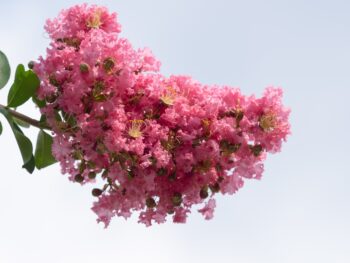
Treatment Options for a Blackened Crepe Myrtle
If you notice blackening on your crepe myrtle, it’s important to act quickly. Here are some effective treatment options:
Rinse the Tree: Use a strong spray of water to rinse the leaves and branches, removing honeydew and some sooty mold from the tree’s surface. This will help slow the spread of mold, though it won’t eliminate the pest issue.
Pruning: Cut away heavily infested branches and leaves, focusing on areas where sooty mold and pests are concentrated. This helps remove affected areas and increases airflow, making the tree less hospitable to pests and mold.
Insecticidal Soap: Apply an insecticidal soap to affected areas to help control aphids and bark scale. Be sure to follow product instructions for the correct application method and frequency.
Horticultural Oils: Horticultural oils, such as neem oil, help kill aphids and CMBS by suffocating the pests. These oils are also effective at reducing honeydew, thus limiting the growth of sooty mold.
Systemic Insecticides: In cases of severe infestation, systemic insecticides is required. These treatments work by being absorbed through the roots or leaves, killing pests when they feed on the tree. Always follow product guidelines and consider professional assistance if needed.
When to Call a Professional
If your crepe myrtle tree has a severe infestation or if treatment methods are not working, it’s best to consult a professional. Professionals will:
- Diagnose the infestation accurately and identify any underlying issues.
- Apply stronger insecticides safely and effectively.
- Offer long-term solutions to prevent future infestations.
In some cases, advanced treatments like soil drenches and trunk injections are necessary to fully address the problem. A professional will ensure that these treatments are done correctly without harming your tree or surrounding plants.
Ryno Lawn Care is here to help with crepe myrtle bark scale infections. Go to our insect control service page for more information.
Conclusion
Seeing your crepe myrtle turn black is disheartening, but with proper diagnosis and treatment, it will return to a healthy, vibrant state. By understanding the role aphids and crepe myrtle bark scale play in causing sooty mold, you are able to take steps to prevent and control infestations. Regular maintenance, proper pruning, and occasional insecticidal treatments will keep your crepe myrtle healthy and pest-free. When in doubt, don’t hesitate to call us to get details on our Southlake landscaping services to ensure your tree gets the care it needs.
References:
Clemson Cooperative Extension. (2024, September 13). Crapemyrtle bark scale. Clemson Cooperative Extension. https://hgic.clemson.edu/factsheet/crapemyrtle-bark-scale/
Gibson, J. (2024, June 27). How to control crape myrtle bark scale! Good Earth Garden Center. https://thegoodearthgarden.com/control-crapemyrtle-bark-scale/

